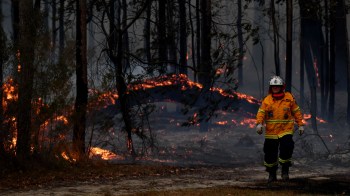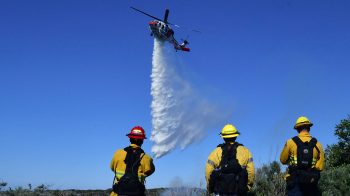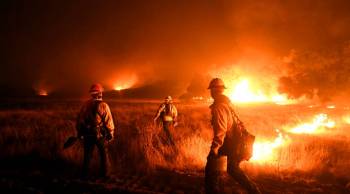
Female fire crew in Colorado clears a path for women in wildland firefighting
Female fire crew in Colorado clears a path for women in wildland firefighting

In the mountains of western Colorado, Raechelle Seil was getting ready to start her workday, unpacking her chainsaw and other tools next to a large pile of branches and brush.
“I was working an office job before this, and I quickly found out I hate office jobs,” she said.
For the past several months, she’s been an assistant lead on a crew of wildland firefighters — one made up entirely of women.
“We’ve been here before the green-up, and now we get to see all the flowers blooming out here, and it’s really, really pretty,” she said, gesturing to Mount Sopris, a nearly 14,000-foot peak that overlooks the valley where she and her crew are working.
As fire season picks up in the West, crews like Seil’s are important in making sure firefighting agencies are ready to respond to dangerous blazes. While it’s a difficult job, many firefighters — like Seil — say it’s rewarding work that keeps them outdoors and makes a positive difference.
Wildland firefighting is a male-dominated career. The U.S. Forest Service estimates that up to 87% of its wildland firefighters are men. Seil’s crew is the result of a partnership between the Forest Service, the Bureau of Land Management and the Western Colorado Conservation Corps, specifically designed to get more women into fire jobs.
Lathan Johnson, an assistant fire manager for the BLM and the Upper Colorado River Interagency Fire Management Unit, helps coordinate the women’s fire crew. He said the program has two benefits: Federal agencies get important work done before the height of fire season, and their workforce is starting to look a little more like society as a whole.
“Whether it’s on wildfire, or whether it’s on something we’re doing here in the office, having that diversity in gender, I think, has always made a better team,” he said.
When the 10-month program is over, the women will be certified to fight wildfires for federal agencies. They’ll have completed all the training they need.

A typical workday starts with the crew getting ready: checking earplugs, putting on gloves and gators, and adjusting chains on their chainsaws.
Crew member Ellie Zaher said when they’re not out here, the women get mentorship, help with their resumes and advice about seasonal jobs.
“They’re all so supportive and, like, they want more women in fire,” she said. “And they’re so happy that we have this program. And they each keep showing us, like, what we should pack and, like, what we should expect.”
And what they should expect is a lot of hard work, not necessarily for high pay.
Minimum wage for federal firefighters is around $15 an hour — which is what the crew is making.
These women work long days carrying heavy loads, sometimes clearing their own trails as they go. They often camp near the job site instead of sleeping in beds.
Eva Heller, another assistant crew lead, said the hard work is rewarding.
“I feel like I’m actually making a difference out here and doing something meaningful, which is, like, so, so awesome,” she said. “And that’s probably my favorite part of the job, apart from working with all of these wonderful people.”
Program coordinators say about 80% of the women who’ve participated in the program in years past go on to jobs in fire for at least the next season.

Raechelle Seil said she feels like she now has lots of career options.
“You can go into the science side of fire, so you can go in after prescribed burns and look at how to mend those lands,” she said. “Or, like, helitack and hotshot and hand crews. Those are all, like, initial attacks.”
Seil said getting a chance to learn the job in a welcoming environment is huge.
“Using, like, all of these, like, bigger tools and all this machinery and stuff like that and not feeling judged and not feeling like you’re inferior,” she said. “It’s very, very nice to feel actually supported and cared for.”
She said she’ll finish out the season on a fire crew, and wherever she ends up next, she plans to stay in natural resources.
There’s a lot happening in the world. Through it all, Marketplace is here for you.
You rely on Marketplace to break down the world’s events and tell you how it affects you in a fact-based, approachable way. We rely on your financial support to keep making that possible.
Your donation today powers the independent journalism that you rely on. For just $5/month, you can help sustain Marketplace so we can keep reporting on the things that matter to you.


















